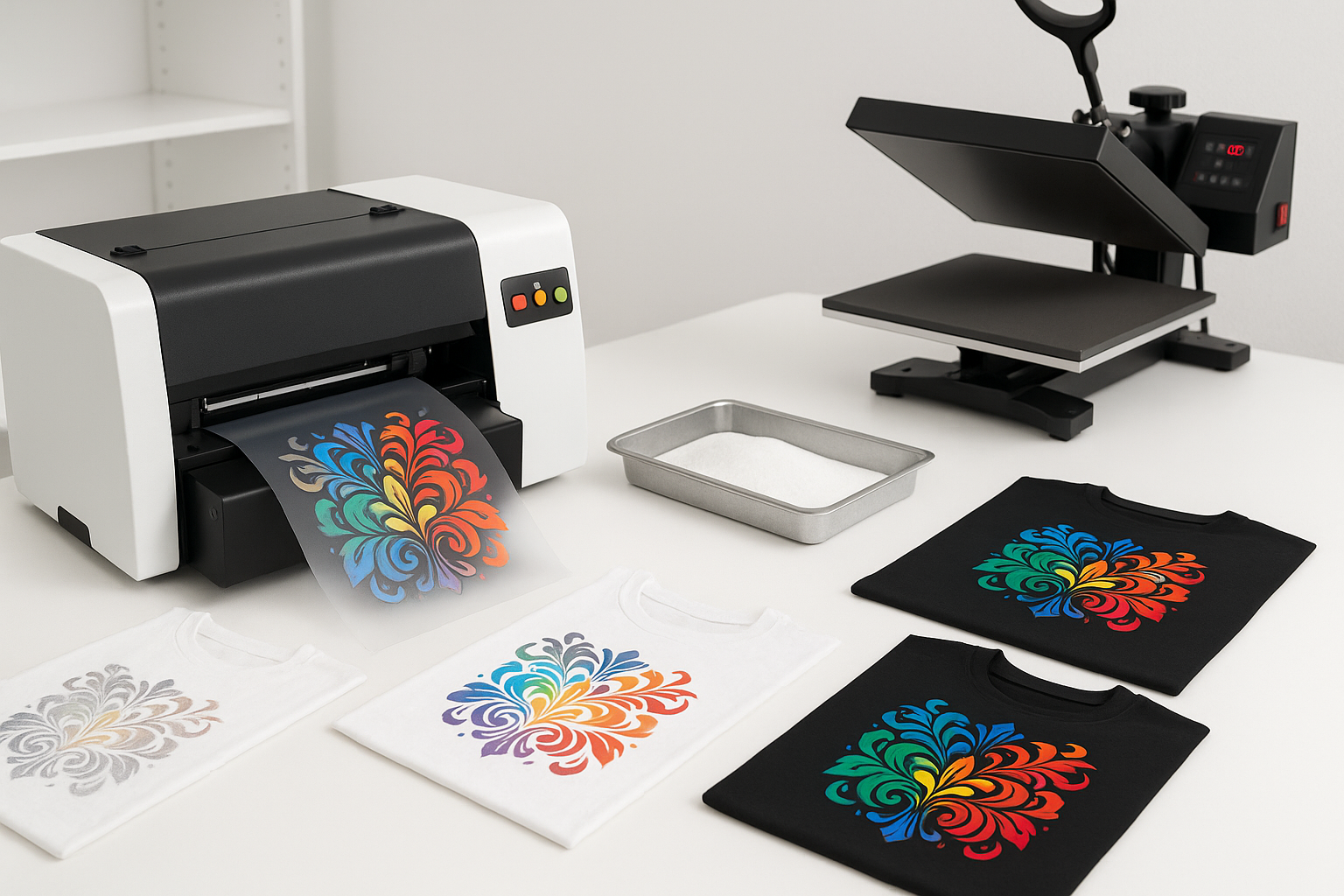Your Ultimate Guide to Troubleshooting and Mastering Direct-to-Film Success
DTF (Direct-to-Film) printing is transforming how we print on textiles. From rich color reproduction to ease of use and broad fabric compatibility, DTF has quickly become the favorite technique among custom apparel shops, small businesses, and print-on-demand entrepreneurs.
But like any growing technology, DTF printing comes with a learning curve. Whether you’re just starting or looking to refine your process, this comprehensive guide will help you avoid common pitfalls and elevate your results.
Let’s dive into the top DTF printing mistakes—and how to avoid them to ensure every print comes out vibrant, durable, and professional.
Skipping Artwork Preparation
Mistake:
Jumping into printing without properly preparing your artwork can result in pixelated, dull, or poorly aligned prints.
How to Avoid:
- Use 300 DPI resolution to ensure sharp details.
- Set your file to CMYK color mode.
- Always mirror your artwork before printing.
- Remove unwanted backgrounds and use clean, defined edges.
Pro Tip:
Use RIP software to adjust color balance and manage white underbase layering for better output.
Using Low-Quality PET Film
Mistake:
Using cheap or low-grade PET film leads to ink bleeding, poor release, or damaged transfers.
How to Avoid:
- Invest in double-sided coated PET films with anti-static properties.
- Choose cold peel or hot peel films depending on your workflow.
- Store films flat in a cool, dry place to prevent warping.
Incorrect Ink and Film Compatibility
Mistake:
Not all DTF inks and films are universally compatible.
How to Avoid:
- Always match your ink with the recommended PET film and printer settings.
- Use DTF-specific pigment inks (especially white ink).
- Avoid mixing brands unless tested beforehand.
Not Using RIP Software Properly
Mistake:
Incorrect RIP software settings can cause poor color accuracy, excessive ink usage, or missing white underbase.
How to Avoid:
- Configure white ink channels correctly.
- Calibrate for each film and fabric type.
- Perform color tests before full production runs.
Applying Adhesive Powder Incorrectly
Mistake:
Uneven powder application results in patchy adhesion or stiff, rubbery prints.
How to Avoid:
- Apply the powder while the ink is still wet.
- Shake off all excess powder thoroughly.
- Use fine-grain adhesive powder for smooth texture.
Pro Tip:
Use a powdering machine or a consistent manual shaking technique for even coating.
Overcuring or Undercuring the Powder
Mistake:
Too much heat can burn the adhesive; too little prevents it from bonding.
How to Avoid:
- Set your curing oven or hover press to 300–320°F (150–160°C).
- Cure for 2–3 minutes or until powder becomes semi-glossy.
- Avoid direct contact between heat press and wet film during curing.
Poor Heat Press Technique
Mistake:
Incorrect temperature, time, or pressure can ruin a transfer.
How to Avoid:
- Use consistent temperature (300–325°F), time (10–15 seconds), and medium to firm pressure.
- Always pre-press garments for 5 seconds to remove moisture and wrinkles.
- Use a Teflon sheet during pressing to prevent scorching.
Peeling the Film Too Early or Too Late
Mistake:
Peeling incorrectly can lift or distort the transfer.
How to Avoid:
- Cold peel film? Wait until completely cool.
- Hot peel film? Peel immediately and smoothly.
- Always follow the instructions for your specific film type.
Skipping the Final Press
Mistake:
Many users forget to repress the fabric, which can lead to poor durability.
How to Avoid:
- Do a second press for 5–10 seconds using a Teflon or parchment sheet.
- This final press helps fuse the ink deeper into the fabric for better wash resistance.
Ignoring Printer Maintenance
Mistake:
Neglecting printer care can cause nozzle clogs, misalignment, and costly downtime.
How to Avoid:
- Perform daily nozzle checks and head cleanings.
- Shake white ink cartridges to prevent sediment.
- Clean the capping station, wiper blade, and surrounding areas weekly.
Letting Ink Sit Too Long
Mistake:
If your printer sits idle, white ink can settle and clog the system.
How to Avoid:
- Print a small test pattern daily.
- Keep white ink circulating (if your system supports it).
- Don’t leave ink in dampers or lines for long periods.
Not Testing New Fabrics
Mistake:
Every fabric behaves differently; assuming they all print the same is risky.
How to Avoid:
- Run test prints on every new fabric or brand.
- Adjust heat press settings based on fabric density and stretch.
Inconsistent Environmental Conditions
Mistake:
Fluctuating temperature or humidity can affect ink flow, drying time, and powder performance.
How to Avoid:
- Keep your workspace at 70–80°F (21–27°C) and 40–60% humidity.
- Use dehumidifiers or fans as needed.
Rushing the Process
Mistake:
Trying to speed up curing or pressing can compromise quality.
How to Avoid:
- Follow time/temperature guides closely.
- Focus on consistency, not speed.
Overusing Adhesive Powder
Mistake:
More powder doesn’t mean better adhesion—in fact, it can create stiff, cracked prints.
How to Avoid:
- Use only enough powder to coat the design evenly.
- Tap or shake off the excess thoroughly.
Not Handling Film Carefully
Mistake:
Touching the printed side or bending the film can distort the transfer.
How to Avoid:
- Always handle PET film by the edges.
- Lay film flat during storage and curing.
Using Expired Ink or Powder
Mistake:
Old consumables can result in color shifts, poor adhesion, or print failure.
How to Avoid:
- Check expiration dates regularly.
- Store inks and powders in a cool, dry, dark area.
Not Cleaning the Heat Press
Mistake:
Residue from adhesive or ink can transfer onto garments.
How to Avoid:
- Clean your heat press plate weekly.
- Use Teflon covers or protective sheets during pressing.
Inaccurate Color Reproduction
Mistake:
Colors on screen don’t match the final print.
How to Avoid:
- Use color calibration tools or RIP profiles.
- Always test new colors or gradients before large runs.
Ignoring Print Head Alignment
Mistake:
Misaligned print heads can cause ghosting or blurry outlines.
How to Avoid:
- Perform alignment tests weekly.
- Realign heads if you see doubled lines or color shifts.
Skipping the Pre-Press on Garments
Mistake:
Moisture or wrinkles under the film ruin adhesion.
How to Avoid:
- Pre-press every garment for 5 seconds before transfer.
- Use this step to check fabric condition and alignment.
Relying on Untrained Staff
Mistake:
Handing DTF production to staff without proper training invites errors.
How to Avoid:
- Create SOPs (standard operating procedures).
- Offer hands-on training for each stage of the process.
Not Monitoring Ink Levels
Mistake:
Running out of ink mid-print leads to banding and wasted film.
How to Avoid:
- Check ink levels daily.
- Refill before reaching critical low points.
Using Incompatible Heat Presses
Mistake:
Cheap or uneven presses result in inconsistent transfers.
How to Avoid:
- Use a reliable, flat-surfaced heat press with consistent pressure.
- Calibrate temperature with a heat gun or thermometer.
Ignoring Post-Press Quality Control
Mistake:
Not checking prints before packaging leads to unsatisfied customers.
How to Avoid:
- Inspect every garment for alignment, adhesion, and defects.
- Perform test washes periodically to ensure durability.
DTF printing is powerful, but even small mistakes can lead to poor results or wasted materials. The good news? Most errors are completely avoidable with the right knowledge, equipment care, and workflow habits.
By avoiding these common DTF printing mistakes, you’ll save time, reduce costs, and impress your customers with prints that are as professional as they are vibrant.
Your DTF Success Starts Here
Need top-tier DTF supplies? Whether it’s premium PET film, vibrant pigment inks, high-bond adhesive powder, or expert support—you’ll find it at DTFSuperPrint.com.
Print smarter. Print cleaner. Print better.
Let’s make every transfer a masterpiece.

